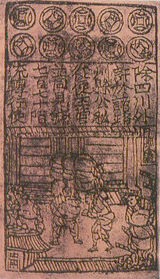
|
This article or section needs to be cleaned up to reach a higher standard of article quality.
Please follow the guidelines of our manual of style and complete this article to a higher level of quality. When this is done, this message may be removed. |

A Jiaozi note.
Jiaozi (Chinese: 交子) was a form of banknote issued around the 10th century in Chengdu during the time of the Song Dynasty (960–1279). It is regarded by most numismatists as the world's first paper money.
History[]
During the 10th century, the jiaozi was first introduced in Chengdu by merchants, looking to replace the bulky iron money issued during the time. Having a high circulation, the government of Chengdu established a bank, which was known as the Bank of Jiaozi. During 1023, the entire Song Dynasty officially began issuing and printing the jiaozi, and banned private issuing.
Though the jiaozi was issued during the Song Dynasty, later dynasties also adopted the use of paper currency, such as the Yuan, Ming, and Qing Dynasties, though they never officially replaced coinage.
Description[]

Banknote seals on jiaozi.
Jiaozi was printed on early paper with black ink. Depicted on these notes were Chinese merchants inside a city. At the top of the note were ten banknote seals, which were used to combat counterfeiting. Underneath these is an inscription reading, "除四川外許於諸路州縣公私從便主管並同見錢七百七十陌流轉行使", which essentially means that, except in Sichuan, the bill may be used in the stead of 77,000 wen of metal coinage.
References[]
- China's Earliest paper money – Jiaozi — Chineseculture.org
交子 on the Chinese (中文) Wikipedia
Jiaozi (currency) on the English Wikipedia
